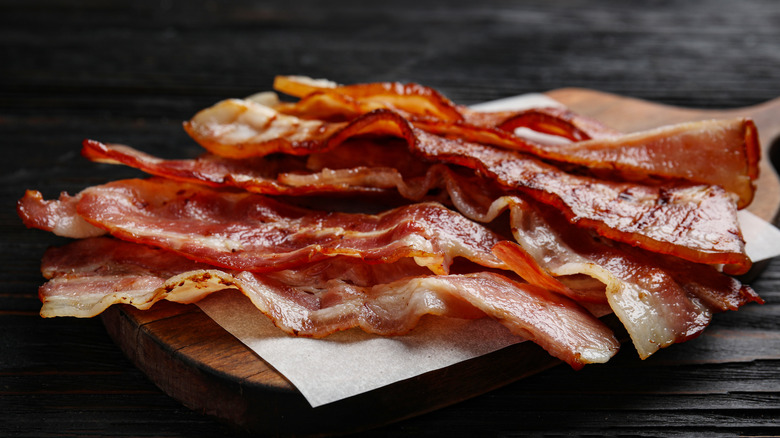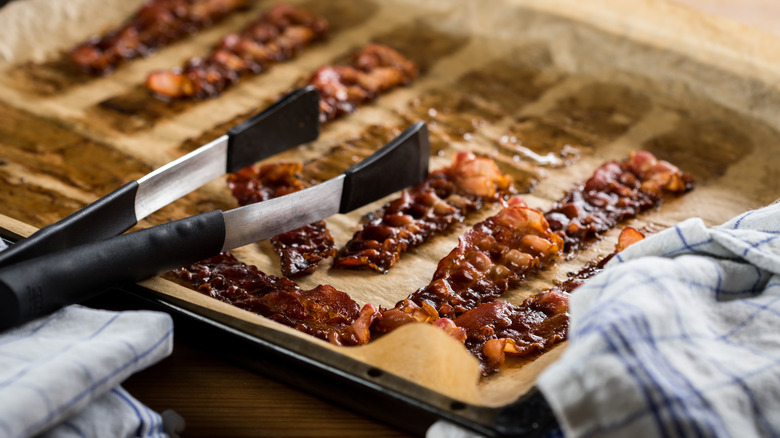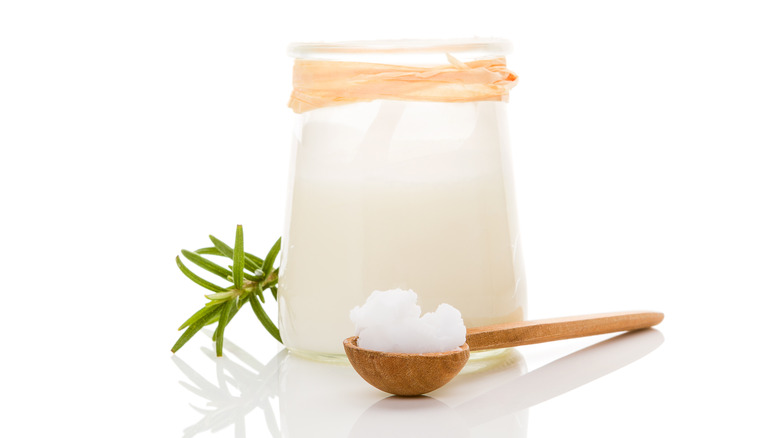Don't Make The Mistake Of Roasting Bacon Without Parchment Paper
How you enjoy bacon is a personal choice. While some prefer the umami-rich food chewy and undercooked, others need it extra-crispy — but there's room for all of us at the table. Whether flanking eggs on a breakfast plate or topping a triple-decker turkey club, bacon adds tons of flavor to recipes and is worth the cleanup, but the mess isn't always necessary — especially with some help from parchment paper.
Skillet cooking bacon was the traditional method for decades, whereas more home cooks now rely on roasting bacon in the oven to avoid grease splatter and provide a more convenient option for batch cooking. Although each new method (microwave, air fryer, and sous vide included) has advantages, oven-roasting allows you to prepare more slices than the traditional frying pan can accommodate and delivers flat strips that don't curl as they cook.
Plus, placing bacon directly on the sheet pan versus using a rack means there is no need to flip each strip; just set the timer and wait. This hands-off cooking method is improved upon by lining the baking sheet with parchment paper, making cleanup even easier. While this doesn't impact how the bacon cooks, it's an invaluable time saver, preventing you from scrubbing and degreasing the used pan when you just want to enjoy breakfast.
How to best line the baking sheet
When cooking bacon in the oven, it's best to use a four-walled sheet pan to contain the grease. You can then line the baking sheet with a single sheet of parchment paper, cutting it large enough for an overhang on each side. This is not the same size offered by convenient pre-cut parchment paper sheets — you'll want to save those for making cookies.
Then, create a dam with the parchment paper, folding the corners and creasing the sides so the rendered fat can't drip onto the pan directly. Once the pan is ready, line the parchment paper with a single layer of bacon slices without overlapping, although the sides can touch slightly since the meat will shrink as it cooks.
When the bacon is cooked to your preferred crispiness, use tongs to remove each slice to a paper towel-lined platter to drain the excess grease. Once the sheet is cool enough to handle but the grease is still warm, lift the parchment paper and slightly tip the bacon grease (aka drippings) into a measuring cup. Discard the parchment paper.
If the sheet pan is thoroughly lined, none of the bacon grease should seep onto the pan, so there won't be stuck-on burnt pieces or a sticky pan to scrub, making cleanup a breeze. Though, remember to not discard fat in the sink's drain. It can harden and wreak havoc on your plumbing, plus you're missing a delicious opportunity to use it for another purpose.
Don't forget to save the bacon drippings
Bacon grease or "liquid gold" can be used instead of cooking oils and butter in any recipe that benefits from a smoky, salty flavor. With a bit of preparation, a sealed jar of bacon fat can be safely stored in the refrigerator for up to three months, or indefinitely in the freezer. Although generations of cooks kept a jar of bacon fat at room temperature accessible near the stove, it's not advised for long-term storage.
While the fat is still warm and pourable, slowly strain it into a metal or glass container using a fine mesh sieve, cheesecloth, or coffee filter to catch any solid masses and discard those pieces. Failing to remove the small bacon bits can make the fat go rancid quicker. Before using it for cooking, be sure to smell the grease and discard anything that smells foul. Additional bacon drippings can be strained and added to the jar in the future to add to your reserves.
The fat will harden as it cools, just like coconut oil, but will remain spreadable, making it easy to use and measure in recipes where you can substitute equal measurements of bacon grease for butter or shortening. Some cooks love it for cornbread or buttermilk biscuits, but bacon drippings can also be used when preparing any vegetable, egg, or pasta dishes. The grease can also be used to season cast iron skillets, so definitely save it for the future.



